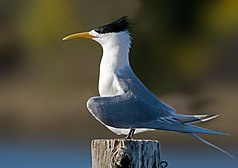Sir Charles Hardy Group National Park
| Sir Charles Hardy Group National Park | ||
|---|---|---|
| Common Tern ( Thalasseus bergii ) | ||
|
|
||
| Location: | Queensland , Australia | |
| Specialty: | Rock islands | |
| Next city: | 140 km from Cape York | |
| Surface: | 131.63 ha | |
| Founding: | 1989 | |
| Black-necked tern ( Sterna sumatrana ) | ||
The Sir Charles Hardy Group National Park (English Sir Charles Hardy Group National Park ) is a 131 hectare national park in Queensland , Australia . It consists of 2 rocky islands and is part of the Great Barrier Reef , a UNESCO World Heritage Site . The park is named after Charles Hardy , a British naval admiral.
location
The national park is located 610 kilometers north of Cairns and 165 kilometers southwest of Cape York on the east coast of the Cape York Peninsula . The islands are about 25 kilometers from Cape Grenville , a headland between Shelbourne and Temple Bay , in the Coral Sea .
The national parks Saunders Islands , Raine Island , Piper Islands and Wuthara Island are in the vicinity .
National nature
The national park consists of two small rock islands. Both are about the same size, almost circular and about a kilometer in diameter. The highest point is 72 meters above sea level.
Flora and fauna
The vegetation consists mainly of grass areas with smaller patches of scrub. Along the coast there are some bays with sandy beaches and pockets of mangrove forest .
Almost untouched by humans, the islands offer numerous animals both habitat and breeding opportunities, including the endangered soot oyster fishermen ( Haematopus fuliginosus ), little terns ( Sternula albifrons ) and reef tricks ( Esacus giganteus ).
The common tern ( Thalasseus bergii ), copper- necked pigeon ( Geopelia humeralis ) and black-necked tern ( Sterna sumatrana ) are particularly common .
The only reptile that has been sighted on the island is the Coastal tree skink ( Cryptoblepharus litoralis ).
Individual evidence
- ↑ Australian Government - CAPAD 2010 ( MS Excel ; 170 kB), DSEWPaC , accessed on October 7, 2012 (English)
- ↑ Australian Government - CAPAD 1997 ( MS Excel ; 93 kB), DSEWPaC , accessed on October 7, 2012 (English)
- ↑ a b c Official website of the park - Species List , Queensland Parks and Wildlife Service , accessed October 7, 2012 (English)


